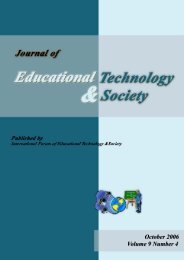Student Engagement: What do we know and what should we do?
Student Engagement: What do we know and what should we do?
Student Engagement: What do we know and what should we do?
You also want an ePaper? Increase the reach of your titles
YUMPU automatically turns print PDFs into web optimized ePapers that Google loves.
student learning, engagement <strong>and</strong> collaboration. We have the technology. We<br />
have the vision. We need to better underst<strong>and</strong> <strong>what</strong> works, especially with<br />
a<strong>do</strong>lescent learners <strong>and</strong> their teachers (Barrett, 2005, p. 23).<br />
“Imparting creative thinking within science <strong>and</strong> technology education requires not only<br />
changing the teaching methods <strong>and</strong> learning environment, but also a<strong>do</strong>pting new<br />
assessment methods such as portfolio assessment, which is based on records of pupils’<br />
activities (Barak <strong>and</strong> Doppelt, 2002, p. 22).<br />
Authors’ summaries of requirements for engagement in learning<br />
Barnes, Marateo, <strong>and</strong> Ferris (2007a) sum up by citing Glenn (2000): ”Net Geners need<br />
self directed learning opportunities, interactive environments, multiple forms of feedback,<br />
<strong>and</strong> assignment choices that use different resources to create personally meaningful<br />
learning experiences” (p. 2). Claxton (2007) summarizes his recommendations of<br />
strategies that promote engagement in learning. He recommends the following eight ideas<br />
as ways to successfully create “epistemic cultures” that support learning how to learn.<br />
1) Language – speak “learnish” (talk about process of learning, nature of<br />
oneself as a learner, one’s improvements <strong>and</strong> intentions as a learner.)<br />
2) Activities – a potentiating milieu (learning is both attractive <strong>and</strong><br />
challenging; activities <strong>and</strong> topics that stretch the learners)<br />
3) Split-screen thinking – the warp <strong>and</strong> <strong>we</strong>ft (keeping both content <strong>and</strong><br />
process in mind; make sure students underst<strong>and</strong> how they just learned<br />
some content; embed meta-cognition into lesson plans)<br />
4) Wild topics – rich, real, responsible (problems or projects are real,<br />
relevant, <strong>and</strong> make a positive difference in some way – real life<br />
feedback <strong>and</strong> benefits for all)<br />
5) Transparency <strong>and</strong> involvement – students as epistemic co-workers<br />
(students are made aware of <strong>what</strong>’s going on, given significant input or<br />
control in assessing their own learning <strong>and</strong> learning styles)<br />
6) Transfer thinking – looking for wider relevance <strong>and</strong> application<br />
(explicitly discussing where current learning could be useful, <strong>what</strong> else<br />
could <strong>we</strong> <strong>do</strong> with this? Where else would this be useful <strong>know</strong>ledge?)<br />
7) Progression – stronger, broader, deeper into subjects <strong>and</strong> learning<br />
8) Modeling – walking the learning talk (Claxton, 2006, pp. 9-14).<br />
When Dunleavy & Milton (2009) discuss the requirements for intellectual engagement,<br />
they note how difficult it is to “pinpoint which classroom practices will be most effective<br />
in supporting it” (p. 13). Ho<strong>we</strong>ver, they summarize the following list of common<br />
instructional “designs for learning that begin with the goal of intellectual engagement:”<br />
1. Emphasize conceptual learning <strong>and</strong> opportunities for students to work with<br />
authentic ideas <strong>and</strong> problems, develop a deep underst<strong>and</strong>ing of ideas, sort<br />
<strong>Student</strong> <strong>Engagement</strong>: <strong>What</strong> <strong>do</strong> <strong>we</strong> <strong>know</strong> <strong>and</strong> <strong>what</strong> <strong>should</strong> <strong>we</strong> <strong>do</strong>? 47












